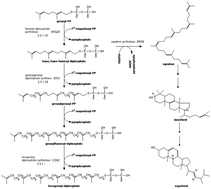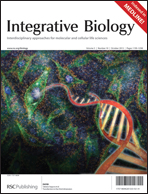ERG9 and COQ1 disruption reveals isoprenoids biosynthesis is closely related to mitochondrial function in Saccharomyces cerevisiae
Abstract
Understanding in vivo regulation of isoprenoid biosynthesis is important for identifying strategies to improve carbon fluxes to desirable endproducts. To study the relevance of gene functions, substrate availability, metabolic flux, and the energetics of resource utilization for isoprenoids biosynthesis, Saccharomyces cerevisiae was co-engineered with endogenous deregulated erg9 and/or coq1 and exogenous plant genes that will lead to sesqui- and diterpene production. The flow of substrates through the MVA pathway statistically showed isoprenoids precursor levels were tightly regulated by erg9 and coq1 genes in S. cerevisiae. Physiological analysis by fluorescent probes and labeling techniques revealed elimination of the competing and/or degrading pathways by gene knockout can increase cellular stresses and change the energy metabolism. To further evaluate the role of erg9 and coq1 in the regulation of isoprenoids synthesis, heterologous terpene synthases from plants were introduced into S. cerevisiae, including the wild-type and mutant strains along with feeding of various metal cofactors under anoxic/oxic conditions. The product distribution in the strains indicated that the energy barrier could be the reason that different metal ion-assisted electrophilic attacks initiated carbocation formation, carbocation stabilization, and rearrangement, incorporating exquisite regio- and stereospecificity, to generate structurally diverse products. The yeast altered in the profile of terpenoids and their precursor pools aided the mechanisms of terpenoid biosynthesis and its regulation, highlighting the need for mitochondrial function when engineering metabolic flux using assumptions based on a comprehensive network of the mitochondrial system.

- This article is part of the themed collection: Synthetic Biology 2012-2014

 Please wait while we load your content...
Please wait while we load your content...